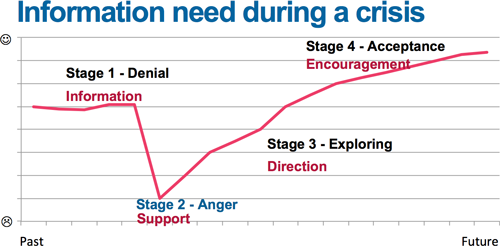Systems, websites and apps get old. They need to be updated. New functionality or a new user flows may be a result of this. Some users like – or at least tolerate – change. But, some users find it very upsetting, on the verge of a crisis when you “move their stuff”. To measure usability in the middle of a crisis would not give a fair result to the new system.
First a little about the emotional journey of the user. The emotional curve a user goes though when they get upset because you update their favourite website can be the same curve as when having a personal crisis. Though, the feelings are not as deep, hurtful and painful, they still follow the same pattern.
 There are ways to handle this – usually with information. And that is the right kind of information at the right time.
There are ways to handle this – usually with information. And that is the right kind of information at the right time.
Stage 1 – Denial
Personal crisis reaction: “This is not happening to me! Loosing my job? Never!”
Changing a system reaction: “What! Changing this brilliant website? No way!”
Information needed – something is changing and the user needs information. Let them know why the change is necessary: “The change is going to affect you and your life. We are doing this for a reason, it is because of…”
Stage 2 – Anger
Personal crisis reaction: “Why me? I’m so pissed off they fired me. I am great at my job! They should have fired someone else!”
Changing a system reaction: “I can’t believe they actually changed it! It was perfect as it was! Why are they doing this to me?”
Information needed – the change is not going away – give the user reassurance: “Don’t worry, your usual stuff will still be here. The change will be for the better.”
Stage 3 – Exploring
Personal crisis reaction: “I wonder what other options are out there…? Perhaps I can…”
Changing a system reaction: “What happens if I click on this new button here…? Maybe that is not so bad…”
Information needed – The user is now starting to familiarise themselves: “Have you seen this new feature? You could use this tool to… Did you know that…?”
Stage 4 – Acceptance
Personal crisis reaction: “Ok, so this is the way it is. I might as well just deal with it and get another job.”
Changing a system reaction: “So, this is the new feature… it’s here, so I may as well use it.”
Information needed – the user is now learning to live with the change: “Make this a part of your life. This is how to get involved.”
So, when IS the right time to deliver the information? Well, that depends on how quickly the user are able to work though a crisis and how frequent users they are to the system. In a more frequently used system where the user visits every day or several times a day it may take a week to get used to the new order of things. If it’s a system that is used once a month it may take a few months.
 So, before ANY change has taken place you have done your baseline measurement. Now, wait patiently until the user have worked themselves though their crisis before you measure again. Let the user use the system at least 4-6 times. So in a frequently used system you can measure after 1-2 weeks. In a rarely used system wait a few months. Then analyse the result and see if more change is necessary.
So, before ANY change has taken place you have done your baseline measurement. Now, wait patiently until the user have worked themselves though their crisis before you measure again. Let the user use the system at least 4-6 times. So in a frequently used system you can measure after 1-2 weeks. In a rarely used system wait a few months. Then analyse the result and see if more change is necessary.
Note: The emotional journey is based on Elizabeth Kübler-Ross’ Stages of grief model, that also contains the stages “Bargaining” and “Depression”. This model is based on the emotional journey of a patient dealing with getting